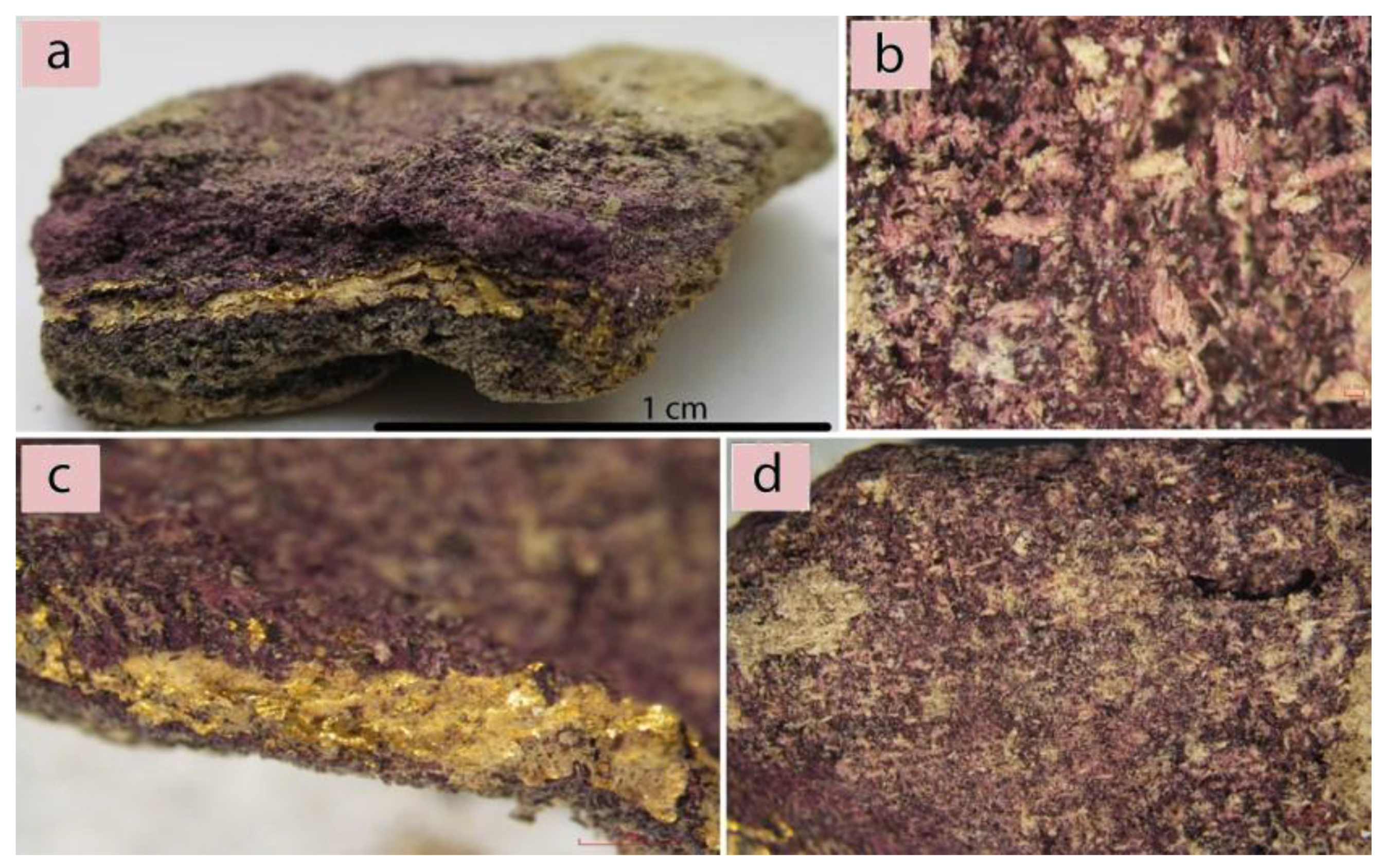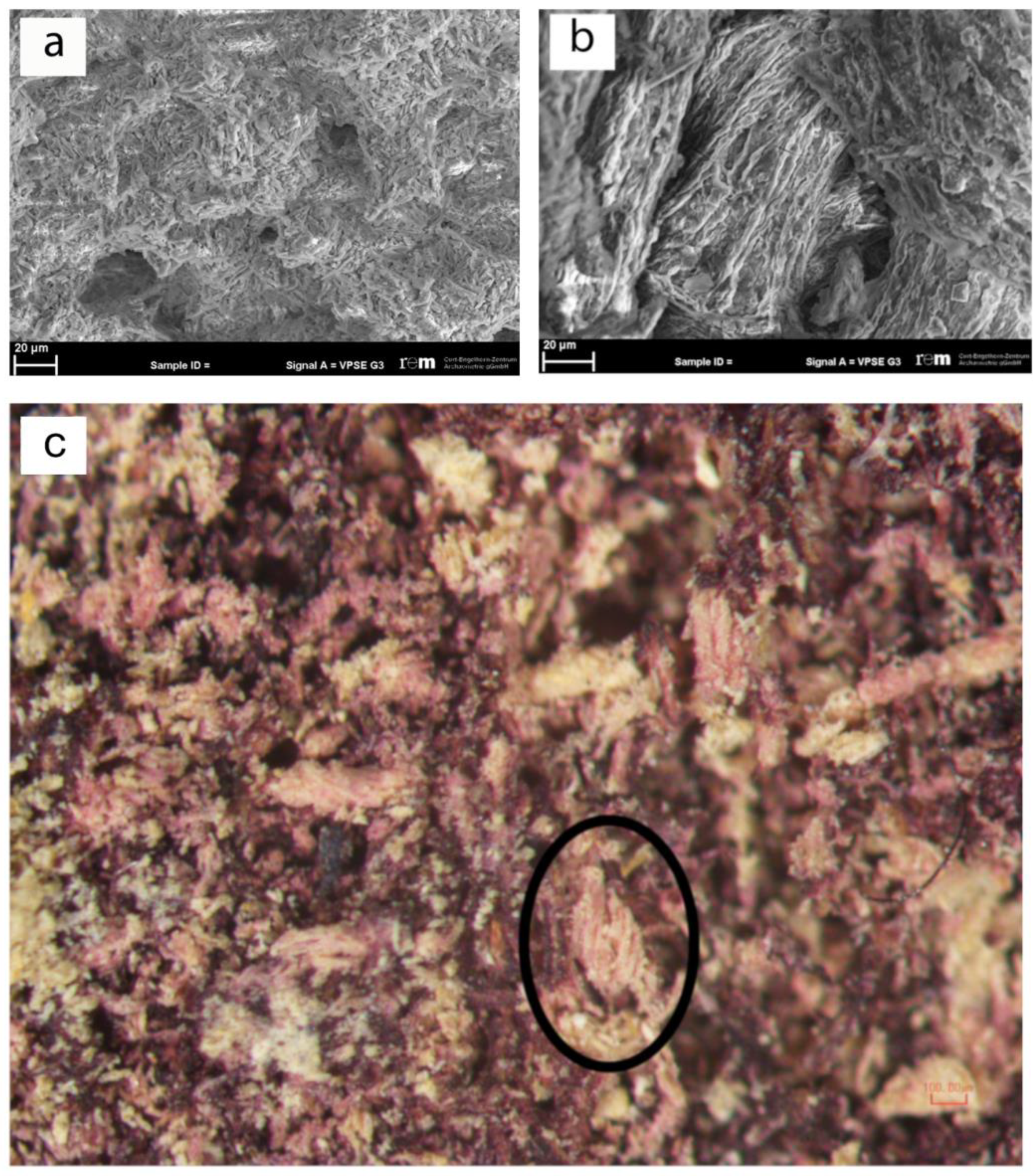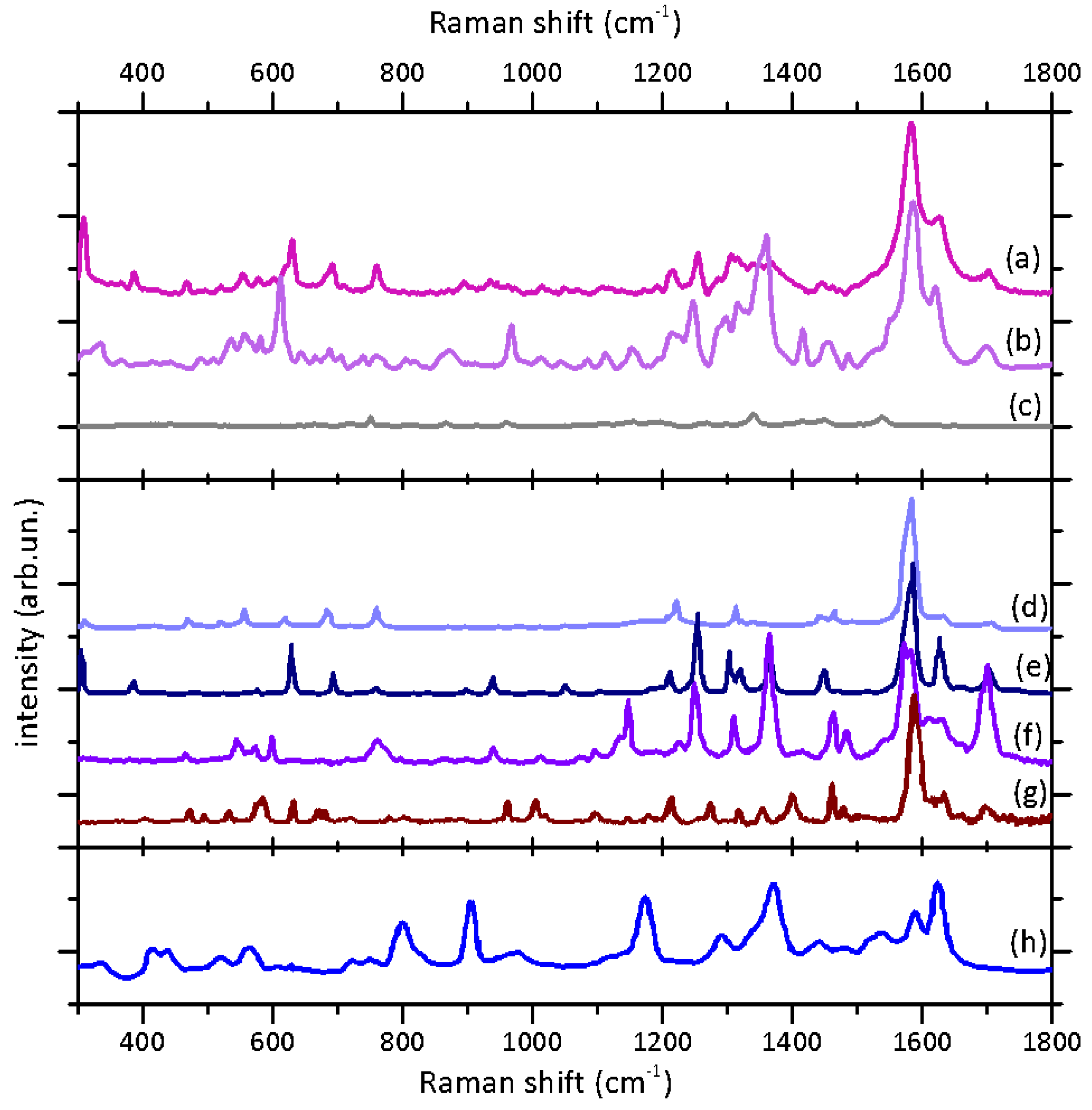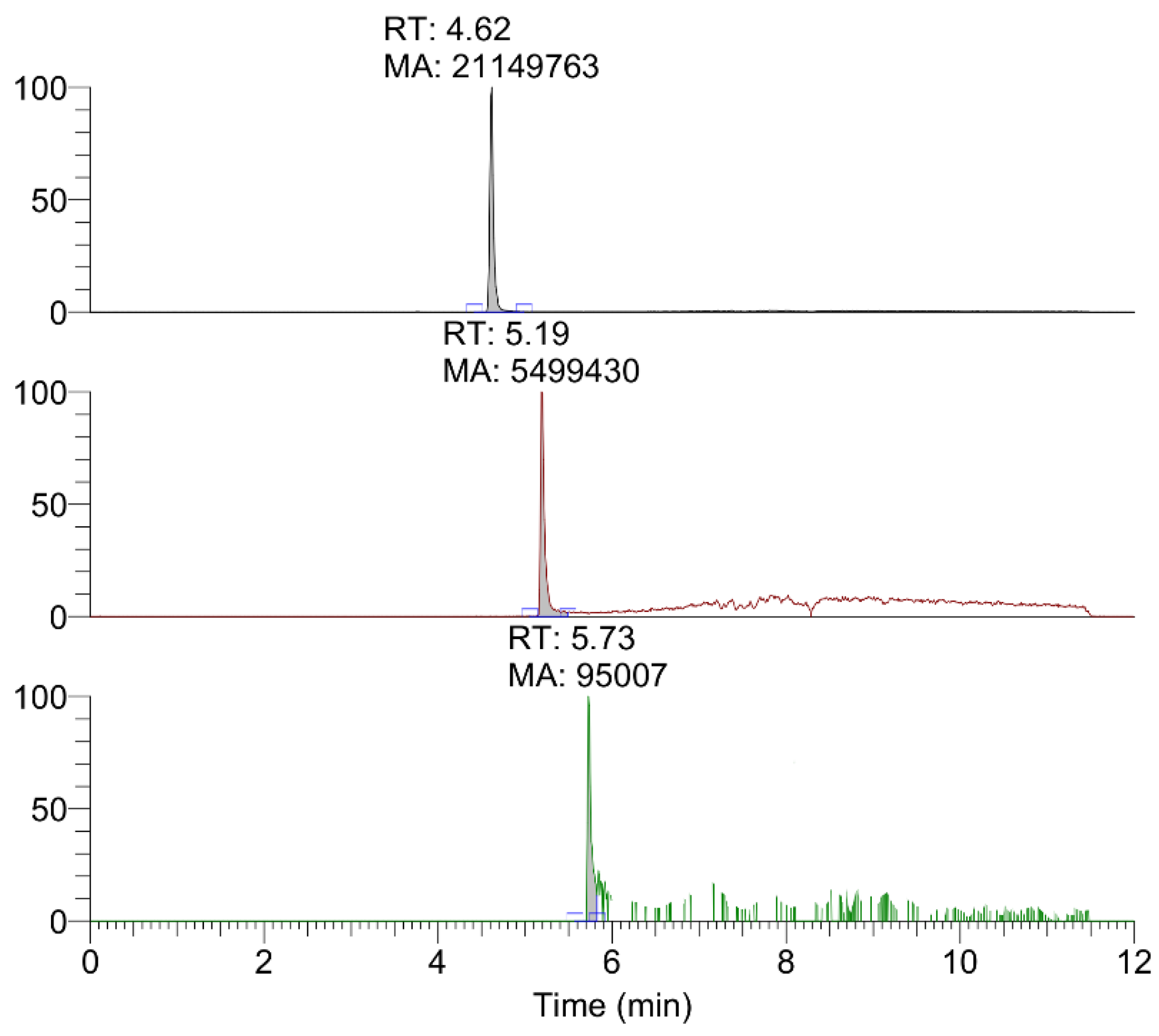Dyes from the Ashes: Discovering and Characterizing Natural Dyes from Mineralized Textiles
Abstract
1. Introduction
2. Results
2.1. Microscopic Techniques
2.2. Raman and SERS Analysis
2.3. HPLC-HRMS Analyses
3. Discussion
4. Materials and Methods
4.1. Materials and Instruments
4.2. Mineralized Dyed Textile
4.3. Extraction Procedure for Purple Dyes
4.4. Preparation of SERS Colloid
4.5. Raman and SERS Analyses
4.6. HPLC-HRMS Analyses
5. Conclusions
Author Contributions
Funding
Acknowledgments
Conflicts of Interest
References
- Good, I. Archaeological Textiles: A Review of Current Research. Annu. Rev. Anthropol. 2001, 30, 209–226. [Google Scholar] [CrossRef]
- Alfaro, C.; Tallenbach, M.; Ortiz, J. Production and trade of textiles and dyes in the Roman Empire and neighbouring regions. In Proceedings of the Actas del IV Symposium Internacional sobre Textiles y Tintes del Mediterráneo en el Mundo Antiguo, Valencia, Spain, 5–6 November 2010; University of Valencia: Valencia, Spain, 2014. [Google Scholar]
- Alfaro, C.; Brun, J.P.; Borgard, P.; Benoit, R.P. Textiles y Tintes en la ciudad Antigua. In Proceedings of the Actas del III Symposium Internacional sobre Textiles y Tintes del Mediterráneo en el mundo antiguo, Nápoles, Italy, 13–15 November 2008; Centre Jean Berard: Nápoles, Italy, 2011. [Google Scholar]
- Alfaro, C.; Karale, L. Vestidos, Textiles y Tintes: Estudios Sobre la Producción de Bienes de Consumo en la Antigüedad. In Proceedings of the Actas del II Symposium Internacional sobre Textiles y Tintes del Mediterraneo en el Mundo Antiguo, Atenas, Greece, 24–26 November 2005; Universitad de València: Valencia, Spain, 2008. [Google Scholar]
- Alfaro, C.; Wild, J.P.; Costa, B. Purpureae vestes. In Proceedings of the Actas del I Symposium Sobre Textiles y Tintes del Mediterráneo en Época Romana, Ibiza, Spain 8–10 November 2002; Universitat de València, Consell Insular d’Eivissa i Formentera: Ibiza, Spain, 2004. [Google Scholar]
- Andersson, E.; Frei, K.M.; Gleba, M.; Mannering, U.; Nosch, M.L.; Skals, I. Old Textiles—New Possibilities. Eur. J. Archaeol. 2010, 13, 149–173. [Google Scholar]
- Busana, M.S.; Gleba, M.; Meo, F.; Tricomi, R. Textiles and dyes in the Mediterranean economy and society. In Proceedings of the Actas del VI Symposium Internacional Sobre Textiles y Tintes del Mediterráneo en el Mundo Antiguo, Altino, Italy, 17–20 October 2016; Libros Portico: Zaragoza, Spain, 2018. [Google Scholar]
- Gleba, M.; Mannering, U. Textiles and Textile Production in Europe: From Prehistory to AD 400; Oxford Books: Oxford, UK, 2012. [Google Scholar]
- Gleba, M. Textiles Studies: Sources and Methods. Kubaba-J. Anc. Southwest Asia East. Mediterr. Stud. 2011, 2, 2–26. [Google Scholar]
- Ortiz, J.; Alfaro, C.; Turell, L. Textiles, basketry and dyes in the ancient Mediterranean world. In Proceedings of the V International Symposium on Textiles et Dyes in the Ancient Mediterranean World, València, Spain; Universitat de València: Valencia, Spain, 2016. [Google Scholar]
- Gleba, M. Auratae Vestes: Gold textiles in the ancient Mediterranean. In Vestidos, Textiles y Tintes, Estudios Sobre la Producción de Bienes de Consumo en la Antigüedad, Purpureae Vestes II; Alfaro, C., Karale, L., Eds.; Universitat de Valencia: Valencia, Spain, 2008; pp. 61–77. [Google Scholar]
- Longo, O. La porpora: Realtà e Immaginario di un Colore Simbolico: Atti del Convegno di Studio; Istituto veneto di scienze, lettere ed arti: Venezia, Italy, 1998. [Google Scholar]
- Cardon, D. Natural Dyes: Sources, Tradition, Technology and Science; Archetype: London, UK, 2007. [Google Scholar]
- Marín-Aguilera, B.; Iacono, F.; Gleba, M. Colouring the mediterranean: Production and consumption of purple-dyed textiles in pre-roman times. J. Mediterr. Archaeol. 2018. [Google Scholar] [CrossRef]
- Vasileiadou, A.; Karapanagiotis, I.; Zotou, A. Determination of Tyrian purple by high performance liquid chromatography with diode array detection. J. Chromatogr. A 2016, 1448, 67–72. [Google Scholar] [CrossRef] [PubMed]
- Karapanagiotis, I.; Mantzouris, D.; Cooksey, C.; Mubarak, M.S.; Tsiamyrtzis, P. An improved HPLC method coupled to PCA for the identification of Tyrian purple in archaeological and historical samples. Microchem. J. 2013, 110, 70–80. [Google Scholar] [CrossRef]
- Cooksey, C.J. Tyrian purple: 6,6′-Dibromoindigo and related compounds. Molecules 2001, 6, 736–769. [Google Scholar] [CrossRef]
- Koren, Z.C. Archaeo-chemical analysis of Royal Purple on a Darius I stone jar. Microchim. Acta. 2008. [Google Scholar] [CrossRef]
- Michel, R.H.; McGovern, P.E. The chemical processing of royal purple dye: Ancient description as elucidated by modern science, part II. Archaeomaterials 1990, 4, 97–104. [Google Scholar]
- Cardon, D. Le Monde des Teintures Naturelles; Belin: Paris, France, 2003. [Google Scholar]
- Koren, Z.C. A New HPLC-PDA Method for the Analysis of Tyrian Purple Components. Dye. Hist. Archaeol. 2008, 21, 26–35. [Google Scholar]
- Ramig, K.; Islamova, A.; Scalise, J.; Karimi, S.; Lavinda, O.; Cooksey, C.; Vasileiadou, A.; Karapanagiotis, I. The effect of light and dye composition on the color of dyeings with indigo, 6-bromoindigo, and 6,6′-dibromoindigo, components of Tyrian purple. Struct. Chem. 2017, 28, 1553–1561. [Google Scholar] [CrossRef]
- Ramig, K.; Lavinda, O.; Szalda, D.J.; Mironova, I.; Karimi, S.; Pozzi, F.; Shah, N.; Samson, J.; Ajiki, H.; Massa, L.; et al. The nature of thermochromic effects in dyeings with indigo, 6-bromoindigo, and 6,6′-dibromoindigo, components of Tyrian purple. Dye. Pigment. 2015, 117, 37–48. [Google Scholar] [CrossRef]
- Vasileiadou, A.; Karapanagiotis, I.; Zotou, A. UV-induced degradation of wool and silk dyed with shellfish purple. Dye. Pigment. 2019, 168, 317–326. [Google Scholar] [CrossRef]
- Koren, Z.C. Scientific study tour of ancient Israel. In ACS Symposium Series; ACS Publications: Washington, DC, USA, 2014. [Google Scholar]
- Kalaitzaki, A.; Vafiadou, A.; Frony, A.; Reese, D.S.; Drivaliari, A.; Liritzis, I. Po-pu-re: Workshops, use and archaeometric analysis in pre-Roman central eastern Mediterranean. Mediterr. Archaeol. Archaeom. 2017. [Google Scholar] [CrossRef]
- Sukenik, N.; Varvak, A.; Amar, Z.; Iluz, D. Chemical analysis of Murex-dyed textiles from wadi Murabba’at, Israel. J. Archaeol. Sci. Rep. 2015. [Google Scholar] [CrossRef]
- Gleba, I. Vanden Berghe, Textiles from Strozzacapponi (Perugia/Corciano). In Production and Trade of Textiles and Dyes in the Roman Empire and Neighbouring Regions. Purpureae Vestes IV; Alfaro, C., Tellenbach, M., Ortiz, J., Eds.; Universitat de València: Valencia, Spain, 2014; pp. 67–173. [Google Scholar]
- Reifarth, N.; Drewello, R. Textile Spuren in der Königsgruft. Vorbericht zu ersten Ergebnissen und dem Potenzial zukünftiger Forschungen. In Interdisziplinäre Untersuchungen zur Königsgruft in Qaṭna, Qaṭna Studien; Pfälzner, P., Ed.; Qaṭna Studien: Wiesbaden, Germany, 2011; pp. 469–482. [Google Scholar]
- Galli, M.; Coletti, F.; Lemorini, C.; Mitschke, S. The ‘Textile Culture at Pompeii’ Project. In Purpureae Vestes VI. Textiles and Dyes in the Mediterranean Economy and Society; Busana, M.S., Gleba, M., Meo, F., Tricomi, R., Eds.; Libros Portico: Zaragoza, Spain, 2018; pp. 267–285. [Google Scholar]
- Schieck, A.P.; Mitschke, S.; Melillo, L. Purpur, Gold und Seide. Textile Vielfalt aus der Asche des Vesuvs. Antike Welt 2014, 1, 15–21. [Google Scholar]
- Macheboeuf, C. Pourpre et matières textiles: Des ateliers aux Tabernae. In Purpureae Vestes I. Textiles y Tintes del Mediterráneo en Época Romana; Alfaro, C., Wild, J.P., Costa, B., Eds.; Universitat de València: València, Spain, 2004; pp. 137–143. [Google Scholar]
- Burgio, L.; Clark, R.J. Library of FT-Raman spectra of pigments, minerals, pigment media and varnishes, and supplement to existing library of Raman spectra of pigments with visible excitation. Spectrochim. Acta Part A Mol. Biomol. Spectrosc. 2001. [Google Scholar] [CrossRef]
- Baran, A.; Fiedler, A.; Schulz, H.; Baranska, M. In situ Raman and IR spectroscopic analysis of indigo dye. Anal. Methods 2010, 2, 1372–1376. [Google Scholar] [CrossRef]
- Karapanayiotis, T.; Villar, S.E.J.; Bowen, R.D.; Edwards, H.G. Raman spectroscopic and structural studies of indigo and its four 6,6’-dihalogeno analogues. Analyst 2004, 129, 613–618. [Google Scholar] [CrossRef]
- Ajiki, H.; Pozzi, F.; Huang, L.; Massa, L.; Leona, M.; Lombardi, J.R. Raman spectrum of monobromoindigo. J. Raman Spectrosc. 2012, 43, 520–525. [Google Scholar] [CrossRef]
- Pozzi, F. Leona, M. Surface-enhanced Raman spectroscopy in art and archaeology. J. Raman Spectrosc. 2016, 47, 67–77. [Google Scholar] [CrossRef]
- Capocefalo, A.; Mammucari, D.; Brasili, F.; Fasolato, C.; Bordi, F.; Postorino, P.; Domenici, F. Exploring the potentiality of a SERS-active pH nano-biosensor. Front. Chem. 2019, 7, 413. [Google Scholar] [CrossRef] [PubMed]
- Bruni, S.; Guglielmi, V.; Pozzi, F. Surface-enhanced Raman spectroscopy (SERS) on silver colloids for the identification of ancient textile dyes: Tyrian purple and madder. J. Raman Spectrosc. 2010, 41, 175–180. [Google Scholar] [CrossRef]
- Ju, Z.; Sun, J.; Liu, Y. Molecular structures and spectral properties of natural indigo and indirubin: Experimental and DFT studies. Molecules 2019, 24, 3831. [Google Scholar] [CrossRef] [PubMed]
- Reifarth, N. Zur Ausstattung spätantiker Elitegräber aus St. Maximin in Trier: Purpur, Seide, Gold und Harze. Int. Archäologie 2013, 124, 511. [Google Scholar]
- Timár-Balázsy, Á. Eascop, D. Chemical Principles of Textile Conservation; Routledge: Abington, UK, 2012. [Google Scholar] [CrossRef]
- Timar-Balazsy, Á. Chemical Principles in Textile Conservation; Butterworth: London, UK, 1998. [Google Scholar]
- Karatzani, A. Metal threads: The historical development. In Textiles and Dress in Greece and the Roman East: A Technological and Social Approach; Tzachili, I., Zimi, E., Eds.; Ta Pragmata Publications: Athens, Greece, 2012; pp. 55–65. [Google Scholar]
- Leopold, N.; Lendl, B. A new method for fast preparation of highly surface-enhanced raman scattering (SERS) active silver colloids at room temperature by reduction of silver nitrate with hydroxylamine hydrochloride. J. Phys. Chem. B 2003, 107, 5723–5727. [Google Scholar] [CrossRef]
- Stauffer, A. Antiker Luxus aus römischen Särgen. Die mittelkaiserzeitlichen Goldgewebe aus Weilerswist-Klein-Vernich und Rommerskirchen. In Textilien Der Archäologie, Materialien zur Bodendenkmalpflege im Rheinland; LVR-Amt für Bodendenkmalpflege im Rheinlan: Köln, Germany, 2011; Volume 22, pp. 61–68. [Google Scholar]
- Wild, J.P. Textilien und das Römische Konzept von Luxus. In Die Macht Der Toga DressCode Im Römischen Weltreich; Tellenbach, M., Schulz, R., Wieczorek, A., Eds.; Verlag Schnell & Steiner: Regensburg, Germany, 2013; pp. 62–63. [Google Scholar]
Sample Availability: Not available. |




| Assignation | Sample | IND (633 nm) | INR (532 nm) | MBI (785 nm) | DBI (633 nm) |
|---|---|---|---|---|---|
| δ(C=C), δ(C=O) | 210 | ||||
| ρ(CH), γ(C=C)2 | 251 | 254 | |||
| γ(C-C=C) | 274 | 266 | 267 | ||
| γ(CC), ν(C=O), ν(CBr) | 309 | 304 | 306 | ||
| γ(CC), ν(CBr) | 364 | ||||
| γ(CC) | 387 | 386 | |||
| 468 | 466 | 471 | 466 | ||
| δ(C=C-CO-C) | 496 | ||||
| ρ(CH), ρ(NH) | 519 | 516 | |||
| δ(CC), δ(CH), δ(NH) | 532 | ||||
| ρ(CH), ρ(CO) | 553 | 545 | 554 | ||
| δ(C=O), δ(CNHC) | 578 | 584 | 574 | ||
| δ(C=O), ν(CC-C-C-CN) | 602 | 599 | |||
| ν(C-C-C), ν(CC-CO-CC) | 619 | ||||
| γ(NH) | 630 | 629 | |||
| δ(CC), δ(CH), δ(NH) | 631 669 | ||||
| δ(CC), ρ(CH), ρ(CO | 674 | 680 | 682 | ||
| δ(CH), δ(NCC) | 691 | 692 | |||
| ν(HN-CC-CO) | 712 | 716 | |||
| δ(CH), δ(NCC) | 760 | 762 | 750 | 757 | |
| γ(CH), δ(CC) ring, ν(CC), ν(CN) | 868 | ||||
| γ(CH), ν(CC), ν(CN) | 893 | 894 | 896 | ||
| δ(CH), ρ(CH) | 935 | 940 | 940 | 937 | |
| δ(CC), δ(CH) | 962 | ||||
| ν(CC), δ(CC) | 1015 | 1013 | 1006 | 1011 | |
| ν(CC), γ(CH) | 1046 | 1048 | |||
| δ(CH) | 1096 | 1097 | 1125 | ||
| δ(CC), δ(CH) | 1135 | ||||
| 1148 | 1161 | ||||
| 1217 | 1224 | 1214 | 1219 | 1211 | |
| ν(CC), δ(CH), δ(C=O) | 1255 | 1250 | 1244 | 1252 | |
| δ(CH), δ(NH), ν(CC) | 1273 | ||||
| ν(CC), ρ(NH-C=C-NH) | 1306 | 1310 | 1308 | 1301 | |
| 1316 | 1317 | 1316 | |||
| ρ(NH-C=C-NH) | 1340 | 1337 | |||
| δ(NH), δ(CH), ρ(CH) | 1350 | 1354 | |||
| 1368 | 1364 | 1362 | 1364 | ||
| 1446 | 1460 | 1441 | 1446 | ||
| 1462 | 1462 | 1479 | 1461 | ||
| ν(C=C) | 1573 | ||||
| 1583 | 1581 | 1587 | 1580 | 1582 | |
| 1613 | 1634 | ||||
| ν(C=O), ν(C=C) | 1628 | 1628 | 1625 | 1625 | |
| ν(C=C) | 1659 | 1657 | |||
| ν(C=O), ν(C=C) | 1702 | 1701 | 1700 | 1700 |
© 2020 by the authors. Licensee MDPI, Basel, Switzerland. This article is an open access article distributed under the terms and conditions of the Creative Commons Attribution (CC BY) license (http://creativecommons.org/licenses/by/4.0/).
Share and Cite
Ciccola, A.; Serafini, I.; Ripanti, F.; Vincenti, F.; Coletti, F.; Bianco, A.; Fasolato, C.; Montesano, C.; Galli, M.; Curini, R.; et al. Dyes from the Ashes: Discovering and Characterizing Natural Dyes from Mineralized Textiles. Molecules 2020, 25, 1417. https://doi.org/10.3390/molecules25061417
Ciccola A, Serafini I, Ripanti F, Vincenti F, Coletti F, Bianco A, Fasolato C, Montesano C, Galli M, Curini R, et al. Dyes from the Ashes: Discovering and Characterizing Natural Dyes from Mineralized Textiles. Molecules. 2020; 25(6):1417. https://doi.org/10.3390/molecules25061417
Chicago/Turabian StyleCiccola, Alessandro, Ilaria Serafini, Francesca Ripanti, Flaminia Vincenti, Francesca Coletti, Armandodoriano Bianco, Claudia Fasolato, Camilla Montesano, Marco Galli, Roberta Curini, and et al. 2020. "Dyes from the Ashes: Discovering and Characterizing Natural Dyes from Mineralized Textiles" Molecules 25, no. 6: 1417. https://doi.org/10.3390/molecules25061417
APA StyleCiccola, A., Serafini, I., Ripanti, F., Vincenti, F., Coletti, F., Bianco, A., Fasolato, C., Montesano, C., Galli, M., Curini, R., & Postorino, P. (2020). Dyes from the Ashes: Discovering and Characterizing Natural Dyes from Mineralized Textiles. Molecules, 25(6), 1417. https://doi.org/10.3390/molecules25061417










